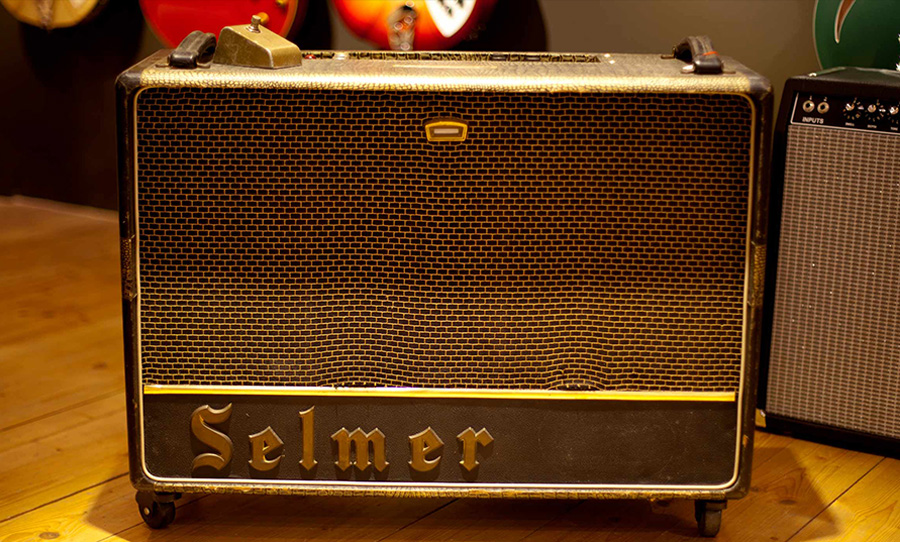It’s hard to think of British amp manufacturers without thinking of Vox or Marshall, but back in the day, brands like Selmer and WEM reigned supreme.
The UK has birthed its fair share of noteworthy guitar amp brands and manufacturers in the last century. However, despite promising starts, some of these have never made the impact that, Vox or Marshall has. Clever marketing and attachment to certain bands that were a part of the British invasion and beyond saw these brands dominate from the ‘60s and into the future, leaving virtually everyone else in the dust.
Ergo, it’s easy to overlook that companies like Dallas Arbiter and Selmer were once – at different points in time – the biggest amp manufacturers in the UK. Selmer amps were, in fact, the first-ever of its kind. Also noteworthy was WEM, headed by renowned innovator Charlie Watkins. All three are practically no more, but in honour of their heydays, let’s take a look back at some iconic vintage amps from these brands that you may have overlooked.

Dallas Arbiter: Sound City
Once upon a time England’s biggest musical instrument company, Dallas Arbiter was the outcome of a 1967 merging of Arbiter Electronics and the practically ancient Dallas Music. First established in 1875, John E. Dallas & Sons thrived on rumours that they made an instrument for a relative of Queen Victoria.
The Sound City instrument line came about as an offshoot of Arbiter’s music shop of the same name located in London’s West End. Prior to the Dallas takeover, Arbiter’s most famous product was the Fuzz Face distortion pedal, used by the likes of Jimi Hendrix. After the merge, amps became Sound City’s biggest selling point, contributing to their topmost position in England’s instrument production market.
Back then, all-tube construction was all the rage, and Dallas Arbiter capitalised on that movement with their whole range of amps. Sound City amps were also advertised for being heavy-duty and usable worldwide, thanks to their variable voltage selectors. Affordability was undoubtedly the most influential factor in high sales, but in this case, cheap didn’t mean low quality.
In 1967, Sound City took off with its “Mark” line of amps, first designed by Dave Reeves – a.k.a. the founder of Hiwatt. Made with Partridge transformers, these initial 100- and 200-watt amps gained a reputation for their power, tonal quality (including bass, middle, treble, and presence controls), and reliability.
Four variations were available, for lead, bass, PA, and all-purpose. Despite being priced for any low-budget musician, the £99 L100 (for lead guitar) had the honour of being approved by Pete Townshend. “Jimi [Hendrix] and his manager Chas Chandler had previously come to see me to ask about buying amps,” Townshend told Guitarist magazine in 1994. “I said that I’d just stopped using Marshall amps at that time and was using a new rig called Sound City, which became Hiwatt, and I said I thought Sound City were better.”
Of course, after Reeves left to focus on Hiwatt, Townshend followed. But Sound City carried on, for a time; the rest of the Mark line was designed by now boutique amp manufacturers Dennis Cornell, who previously worked under Reeves. Such vintage models are still buyable nowadays, albeit fairly higher-priced than they used to be!
WEM
Charlie Watkins (of Watkins Electric Music) is best known for his Watkins Copicat tape-echo unit, but he was no slouch in the amp market either. He started making his own in 1952, three years after opening his own music shop in London and was then able to get a foot in on the rise of rock ‘n’ roll.
Besides the Copicat, Watkins is also credited with inventing the master/slave PA systems that, with their unprecedented 1000+ watts, brought to life all of the big UK pop festivals of the late 60s and early 70s.
After throwing together the Audiomaster mixer and ER hundred-watt transistor amps especially for Pink Floyd, Watkins boasted that the band members were “immediately impressed… the only proper PA system capable of taking more than a hundred watts” (a quote from Syd Barrett & Pink Floyd: Dark Globe by Julian Palacios).
The Dominator V-front was WEM’s other big hit in the amp arena, reportedly used by every big-name British guitarist of the day. According to Watkins, the distinctly angled speakers (of the original 1956 versions) were designed to produce a wider spread of sound; moreover, they were very eye-catching indeed, especially with the early turquoise/white or red/white coverings. A second version of the amp (Mk II, released in 1964) went more classic and conventional with a tall black cabinet.
Surprisingly, the original colourful V-front beauties are coming back, thanks to John Beer of Amp-Fix. Before passing away in 2014, Watkins himself approved of the limited edition reissue, orders for which can still be taken today. Like the original, the new Dominators include two channels and nifty tremolo features.
Selmer
Selmer was established in 1928 with the union of Henri Selmer and Ben Davis, and together they were the first British company ever to sell amplifiers (initially imports from the US). In 1935, Selmer started producing their own amps, and by the time of World War II, they were the biggest musical instrument company in the UK. After taking over the small PA Selmer amp business known as RSA, Selmer expanded to guitar amplification in 1947.
Besides giving birth to a number of legendary guitar amps, Selmer was also known for distributing some very popular guitars from the ‘50s to the early ‘70s, including Hofner, Fender, and Gibson. In 1974, Selmer was purchased by organ producers CMI and production of amps died out by the early ‘80s. Henri Selmer himself continued on his own in France with his famed wind instruments.
Selmer’s first venture into guitar amps was with the RSA Truvoice series, early models of which were fairly modest and rudimentary with 8-inch speakers. They also posed some danger due to lacking mains transformers, although that was rectified by the ‘50s.
Perhaps most notable in the Selmer-Truvoice catalogue is the U12 PA system (1946-1958), which is said to have been used by the Beatles in their rookie days. Purportedly, Liverpool Art College’s student’s union gifted it to the band in the late ‘50s or early ‘60s. It’d certainly have come in handy, what with including two microphone inputs and even a microphone itself.
Besides the Beatles, Selmer’s Zodiacs are also known for being embraced by some big names. The Zodiac Twin 30 combo especially is famed for its usage on the iconic guitar riff from House of the Rising Sun. Purportedly, after much online debate, The Animals’ lead guitarist Hilton Valentine disappointed Vox fans by proclaiming in an email, “No, it definitely wasn’t an AC30, I think it was a Selmer.”
The Twin 30 is still used today by Arctic Monkeys’ Alex Turner, as well as Alex Kapranos from Franz Ferdinand.
Although the Zodiacs were pretty much Selmer’s Automatic Selectortones (early ‘60s) on the inside, the Twin 30 drew more attention for its “crocodile skin” finish and “blinking eye” indicator for the speed of the amp’s tremolo. The Zodiac is known for its tonal versatility thanks to its “Selectortone” button controls that range from high treble to contrabass. These Selectortone controls only govern one of the amp’s two channels, while the other operates independently. This is, of course, ideal for dual microphone and instrumental amplification minus cross-channel interference.
Like Vox’s amps during that time, the Twin 30s used Celestion alnico-magnet speakers, two 12-inches (which were later upgraded to sturdy Goodman ceramic magnets for the Twin 50s). All in all, it’s a rightfully very sought-after product that you’ll have to cough up a few grand for today.


